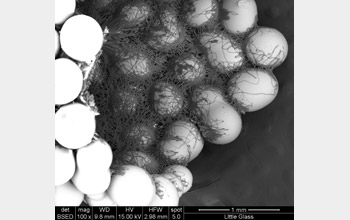Multimedia Gallery
Caddisfly Larva (Image 3)
This picture from a scanning electron microscope, magnified 100 times, shows a mesh of wet adhesive silk ribbon produced by a caddisfly larva to stitch together the inside of its shelter case that was made with glass beads it was given in a laboratory aquarium.
Russell Stewart, an associate professor of bioengineering at the University of Utah, is principal investigator of a study on the chemical and structural properties of caddisfly silk that was funded by the National Science Foundation (grant DMR 09-06014). He has characterized the caddisfly's wet adhesive silk and hopes to develop a synthetic version that could be used as a surgical adhesive in surgery.
Working in his lab, Stewart, who studied the caddisfly species B. echo from the lower Provo River, Utah, discovered that caddisfly adhesive can bond to a wide range of surfaces underwater, including hard and soft and organic and inorganic. Such adhesion could be used on a wide range of tissue types in the medical field.
To learn more about Stewart's research, see University of Utah press release, "Glue, Fly, Glue--Caddisflie's Underwater Silk Adhesive Might Suture Wounds." (Date of Image: 2009) [Image 3 of 3 related images. Back to Image 1.]
Credit: The University of Utah
Images and other media in the National Science Foundation Multimedia Gallery are available for use in print and electronic material by NSF employees, members of the media, university staff, teachers and the general public. All media in the gallery are intended for personal, educational and nonprofit/non-commercial use only.
Images credited to the National Science Foundation, a federal agency, are in the public domain. The images were created by employees of the United States Government as part of their official duties or prepared by contractors as "works for hire" for NSF. You may freely use NSF-credited images and, at your discretion, credit NSF with a "Courtesy: National Science Foundation" notation.
Additional information about general usage can be found in Conditions.
Also Available:
Download the high-resolution JPG version of the image. (1.8 MB)
Use your mouse to right-click (Mac users may need to Ctrl-click) the link above and choose the option that will save the file or target to your computer.

